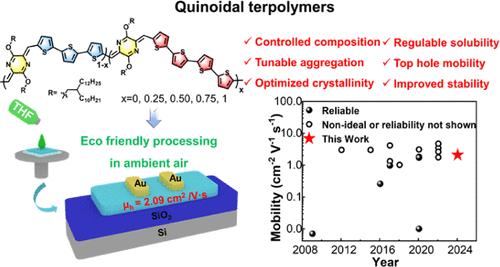用于高性能环保晶体管的Quinoidal三元聚合物链间聚集和薄膜结晶度的精确调控
IF 5.2
1区 化学
Q1 POLYMER SCIENCE
引用次数: 0
摘要
在加工高性能共轭聚合物时广泛使用有毒卤化溶剂,引起了环境问题,并阻碍了大规模有机电子产品的生产。虽然三元共聚物方法改善了供体-受体聚合物的性能,但它在quinoidal体系中仍未被探索。这项研究开创了quinoidal聚合物的三元共聚物策略,通过微调链间聚集和薄膜结晶度来实现生态友好的加工,从而提高了有机场效应晶体管(ofet)的电荷迁移率和稳定性。研究人员开发了一系列对氮杂基二甲烷基无规三元聚合物,这些三元聚合物具有不同比例的噻吩(3T)和季噻吩(4T)单元,表明较高的4T含量增强了链间聚集,但降低了溶解度,显著影响了分子的堆积和OFET性能。当由氯苯加工时,所有三元共聚物的性能都优于对照交替共聚物,其中PA-3T25-4T75含有75%的4T,由于其最有序的微观结构,其空穴迁移率最高,为2.26 cm2 V-1 s-1。值得注意的是,含25% 4T的PA-3T75-4T25在四氢呋喃溶剂下实现了令人印象深刻的2.09 cm2 V-1 s-1的空穴迁移率,标志着由环保溶剂加工的quinoidal聚合物的最高价值。这项工作强调了三元共聚物设计在提高quinoidal聚合物的OFET性能和环境可持续性方面的潜力,有助于环保有机电子产品的发展。本文章由计算机程序翻译,如有差异,请以英文原文为准。

Precisely Regulating Interchain Aggregation and Film Crystallinity of Quinoidal Terpolymers for High-Performance Eco-friendly Transistors
The widespread use of toxic halogenated solvents in processing high-performance conjugated polymers raises environmental concerns and hinders large-scale organic electronics production. While the terpolymer approach has improved the donor–acceptor polymer performance, it remains unexplored in quinoidal systems. This study pioneers a terpolymer strategy for quinoidal polymers to enable eco-friendly processing by fine-tuning interchain aggregation and film crystallinity, leading to improved charge mobility and stability in organic field-effect transistors (OFETs). A series of para-azaquinodimethane-based random terpolymers with varied ratios of terthiophene (3T) and quaterthiophene (4T) units are developed, demonstrating that higher 4T content enhances interchain aggregation but reduces solubility, dramatically affecting molecular packing and OFET performance. When processed from chlorobenzene, all terpolymers outperformed reference alternating copolymers, with PA-3T25-4T75 containing 75% 4T achieving the highest hole mobility of 2.26 cm2 V–1 s–1 due to its most ordered microstructure. Notably, PA-3T75-4T25 with 25% 4T achieves an impressive hole mobility of 2.09 cm2 V–1 s–1 with tetrahydrofuran as the solvent, marking a record high value for quinoidal polymers processed from eco-friendly solvents. This work underscores the potential of terpolymer design in enhancing both OFET performance and environmental sustainability of quinoidal polymers, contributing to the development of eco-friendly organic electronics.
求助全文
通过发布文献求助,成功后即可免费获取论文全文。
去求助
来源期刊

Macromolecules
工程技术-高分子科学
CiteScore
9.30
自引率
16.40%
发文量
942
审稿时长
2 months
期刊介绍:
Macromolecules publishes original, fundamental, and impactful research on all aspects of polymer science. Topics of interest include synthesis (e.g., controlled polymerizations, polymerization catalysis, post polymerization modification, new monomer structures and polymer architectures, and polymerization mechanisms/kinetics analysis); phase behavior, thermodynamics, dynamic, and ordering/disordering phenomena (e.g., self-assembly, gelation, crystallization, solution/melt/solid-state characteristics); structure and properties (e.g., mechanical and rheological properties, surface/interfacial characteristics, electronic and transport properties); new state of the art characterization (e.g., spectroscopy, scattering, microscopy, rheology), simulation (e.g., Monte Carlo, molecular dynamics, multi-scale/coarse-grained modeling), and theoretical methods. Renewable/sustainable polymers, polymer networks, responsive polymers, electro-, magneto- and opto-active macromolecules, inorganic polymers, charge-transporting polymers (ion-containing, semiconducting, and conducting), nanostructured polymers, and polymer composites are also of interest. Typical papers published in Macromolecules showcase important and innovative concepts, experimental methods/observations, and theoretical/computational approaches that demonstrate a fundamental advance in the understanding of polymers.
 求助内容:
求助内容: 应助结果提醒方式:
应助结果提醒方式:


